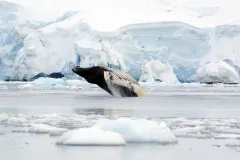Humpback Whales in Antarctica: What Are the Whales Doing?

Humpback whales (Megaptera novaengliae) are the most abundant baleen whale in the nearshore waters around the Antarctic Peninsula. They, along with millions of penguins, seals, seabirds, and other whales, feed primarily on Antarctic krill (Euphausia superba) during summer months. For a large 50-foot humpback whale, there needs to be a significant amount of these tiny, shrimp-like prey available to make the energetically costly act of lunge feeding worth the effort! But very little is known about how these ocean giants maneuver around to locate and feed on these small crustaceans. To learn more, our eight-person research team will begin working around the clock for three weeks aboard a ship in the Antarctic Peninsula to track the whales and learn more about their feeding and migration habits.
We will spend our days deploying electronic tags, attached to the whales with suction cups, which track the underwater movement and feeding behavior of individual whales for 24 hours at a time, and mapping the distribution of their prey using echosounders. The suction cup tags collect information on the depth, speed, pitch, roll, and heading of the whale as well as the sounds that the whale makes and hears. While the whales are carrying these tags, we map the locations and densities of groups of schooling krill to determine which are the most attractive to whales – do they prefer shallow groups, dense groups, large groups, or some combination? Once the tags come off the whale, we retrieve them, download the data and are able to determine when, where and how deep the whales were feeding.
We will also deploy longer-term tags that transmit the whale’s location via satellite several times a day for up to 6 months. These long-term tags can give us unprecedented information on the day-to-day roaming habits of the whales. During summer months, krill are distributed broadly over a large area, found in groups ranging from the size of a watermelon to that of an aircraft carrier! The satellite tags will let us know how long whales hang around these groups and if, as the seasons change, they choose to follow krill inshore or begin their migration to tropical breeding grounds. We are interested in finding out which animals stay the longest, which leave the earliest and where these whales go.
While the information from the suction cup tags will be immediately available to us, the satellite tags remain with the whales for months, well after our research team leaves Antarctica. We will report back after our trip to let you know what we have learned about where these whales go and how they make a living in these icy waters!
Editor's note: What's it like to work in Antarctica and tag whales? Follow Ari and the team of researchers daily on their blog. And check back here in a few weeks to see what they learned about humpback whales.

